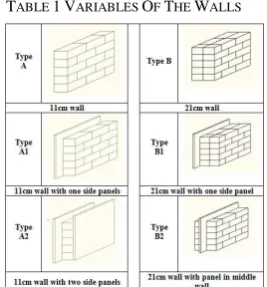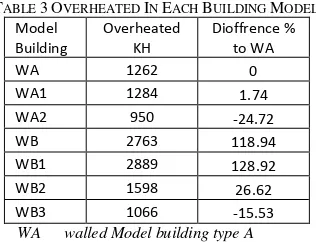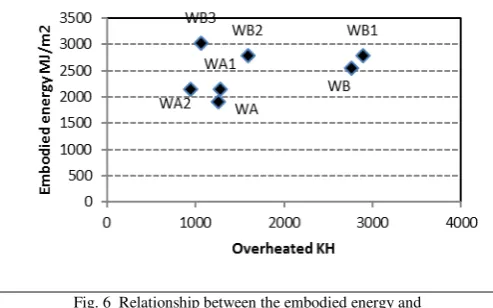ICETEA 2015
-- Page 16 of 115 --
ISSN 2470
-
4330
Heat Energy and Embodied Energy Efficient in
Building Walled and Roofed Compressed Earth
Block in the Tropics Case Study in Surabaya
Vincentius Totok Noerwasito
Department of Architecture, Institut Teknologi Sepuluh NopemberSurabaya
Abstract— Building materials were a major influence on the condition of the air inside the building covering the walls and roof of the building materials. This was caused by an area of the walls and roof that dominates the surface area of the building. Buildings that save energy by sustainable building is a building that is much use of local building materials. One wall of the building materials which are of local building materials and do not use a lot of energy in the manufacturing process is compressed earth block (CEB). Energy for heating and cooling of buildings are depending on the location where the building is located.
This study aims to determine the appropriate building walls for warm and cold climate areas. Simulations carried out by using a model of the building with a size of 3 x 3 x 3m. Heat energy and embodied energy of building materials in the building model is calculated using the program. Variables research are CEB wall thickness and fiber concrete panels. Optimization was done to determine the model of the building that has heat energy and embodied energy balance.
Results of the study are as follows a model that is suitable for hot climates are model-walled half-brick and concrete fibre panels coated on both sides. Model suitable for cold climates is a model that has a brick wall and covered by fibre concrete on the outside.
Keywords: CEB walls; concrete fibre panels; roof CEB; heat energy; embodied energy.
I. INTRODUCTION
Indonesia is a tropical area that has a different temperature between the region. It is caused by the location of the area. Areas that are in the plateau will have a lower temperature than in lowland areas. It should be the same character climate in Indonesia is the dry season and the rainy season. In low-lying areas or in the highlands of Indonesian people have a comfort standard at 24 - 28oC. The use of building materials determines the condition of the air inside the building. Building materials have a major influence on the condition of the air inside the building are the walls and roof of the building materials. This was caused by an area of the walls and roof that dominates the surface area of the building. Use of these types and quantity of building materials should be limited in order to keep of sustainable buildings. Buildings that save energy by sustainable building is a building that is much use of local materials. This is due to the usage of local
materials will conserve natural resources, especially petroleum materials.
The research looked at the use of materials with a combination of wall and roof to heat energy and embodied energy that occurs due to the use of wall and roof types. The type of material used is of local materials. Heat energy is the energy used building materials to cool the air of into the building to air of outside the building. The embodied energy is energy that is used for the production of building materials from raw material into finished materials.
One wall of the building materials which are of local building materials and do not use a lot of energy in the manufacturing process is compressed earth block (CEB). The raw material of this block is earth the surrounding. CEB making process is without going through the process of combustion such as red brick. The manufacturing process requires only a process of compaction and drying naturally. By using local building materials will have a relatively low embodied energy. This study uses the CEB building materials as the walls and roof of the building.
Energy for heating and cooling of buildings depending on the location where the building is located. In lowland areas is the energy required to cooling the energy in the building. While building on the highlands area required heating energy. Therefore in this study conducted a study of the condition of the air inside the building by using some kind of wall. So that later it can be seen a certain kind of wall that correspond to areas in the highlands or lowlands.
II. RESEARCHMETHODS
ICETEA 2015
-- Page 17 of 115 --
ISSN 2470
-
4330
Fig. 1 Flow of thought research
Research carried out can be seen in Figure 1, the following: the result of previous studies is the composition of a compressed earth block which has standards for walls. The composition obtained in these studies is 12% cement, 10-12% lime by weight of soil.
Determination of the model was done by comparing the size of the bedroom minimum. In general, the size of the bedroom is 3 x 3 m. Model building is shape of the room in the building. Alternative design wall was conducted to obtain the conditions of temperature at night. For that was made difference thickness wall. Wall thickness is a variable of the study. Alternative walls can be seen in Figure 2. Development of variable is depending on the condition of the building.
Fig. 2 Alternative wall
Simulation of thermal energy calculations performed using programs Archipak and standards embodied energy. As a variable is the type and thickness of the wall. Wall material is compressed earth block (CEB) that are made from local. Insulation material is material that is often used in these places. CEB also use the building roof. Model building is a building with a size of 3 x 3x 3 m, research location chosen was the city of Surabaya. Energy optimization made to the heat energy in the building and the embodied energy of the building. Plan model can be seen in Figure 3.
The results obtained are conditions of heat energy and embodied energy optimal buildings. The thickness of the wall that has overheated high and low embodied energy chosen as a good alternative to the thick walls in warm area. While the
type of wall that has overheated lower and lower embodied energy is in accordance with the building walls in the cold area.
III. DISCUSSIONANDRESULTS
The research activities conducted in Surabaya. The conditions of temperature average 330 C and average humidity 80%. Surabaya is a warm climate. As a model in the study was a building with walls and roof materials with materials compressed earth block. Calculation of heat energy and embodied energy of the models was in the area of Surabaya. There are two model chosen. The model was a model that is suitable for warm climates and models suitable for cold climates.
Compressed earth block is a building material for walls that do not go through the process of combustion, but rather use the natural drying process. This study uses a compressed earth block made of local soil and use additional material is cement and lime. As material for thermal insulation use a thin lightweight panel.
Fig. 3 building model
The type of building wall that is a variable wall is a development with a wall thickness of 11 cm and 21 cm. Besides, both these walls have thermal insulation which is located beside the outside, inside or middle of the wall. The heat insulating wall material is often used for walls of buildings, namely fiber concrete. The wall follows the shape variable (Table 1).
The compositions of the wall on the table 1 have different thermal characteristics. Due to the thick walls and the location of the fibre concrete layer, the models have a different thermal properties value. Thermal properties of the wall can be seen in the table 2.
ICETEA 2015
-- Page 18 of 115 --
ISSN 2470
-
4330
TABLE 2 THERMAL PROPERTIES OF THE WALLS
Calculated by Archipak
Besides wall thickness is used, it should be also added variable wall layers are often used. While the wall is concrete fibre panels.
Heat Energy
One of method to obtain optimum wall it must know influential factors. The factor is heat energy. In addition to variable wall thickness used, coupled variable wall layer that is often used in general, the fibre concrete panel walls. Roof of the building made with compressed earth blocks. All variables in the model have a different notation. Heat energy is obtained from overheated in buildings per year. Calculation overheated buildings annually using Archipak program. The following year overheated value on all models of the buildings on the table 3.
TABLE 3OVERHEATED IN EACH BUILDING MODEL Model
Building
Overheated KH
Dioffrence % to WA
WA 1262 0
WA1 1284 1.74
WA2 950 -24.72
WB 2763 118.94
WB1 2889 128.92
WB2 1598 26.62
WB3 1066 -15.53
WA walled Model building type A
At the table 3 comparisons of the increase and decrease in overheated value of each model to the basic model (WA) are highly variable. Difference biggest increase contain in the model WB1 which amounted to 129%. While the decline in overheated contained in the model WA2 which amounted to 24%. Decline in value overheated on a particular model is suitable for the model in cold climates.
In the Figure 4 shows the value overheated not linear on all models of the buildings. Overheated value chart is a line up and down. Value overheated initially relatively flat, and then rose sharply, after it overheated value decreases. This indicates that there are values overheated maximum and minimum. Minimum value is WA2 and WB3 models, while the maximum value is WB1 and WB models. WA is the neutral value of the model. On this graph shows not all thick walls have high overheated.
Fig. 4 Graphic overheated of each model
Embodied Energy
Embodied energy is the energy production
process of the material which determines the
amount of energy embodied the building. Inside the
building model there is a thickness of the wall
varying, so that it will get the value embodied
energy differently. To compare the embodied
energy necessary to know the value of energy is in
the form of unit ie per m
2. Here the value of energy
is in each building model (table 4).
TABLE 4EMBODIED ENERGY OF EACH MODEL
Building Models Embodied energy MJ/m2
Difference % to WA
WA 1914 0
WA1 2152 12.44
WA2 2152 12.44
WB 2555 33.49
WB1 2793 45.94
WB2 2793 45.94
WB3 3032 58.39
At the table 4 it appears that the increase in the value embodied energy of each model building. The maximum value of the difference of energy embodied in this study was 58%. The maximum value of the increase in energy embodied was indicated by the model WB3, where the model has a relatively thick wall with both sides coated with fibre concrete panels. Increased energy embodied tend linear flat. (Figure 5). This shows an increase in embodied energy not significant.
ICETEA 2015
-- Page 19 of 115 --
ISSN 2470
-
4330
Optimization
Optimization was done determines the most efficient model in value heat energy and its embodied energy. This was done because the model that has a low heat energy or low embodied energy chosen as the most efficient model. As the main criteria the selection of the best model is hot or overheated energy it has. Low overheated suitable for cold climates, while high overheated suitable for warm climates.
Fig. 6 Relationship between the embodied energy and Overheated of models
Figure 6 shows the position of embodied energy and overherated each model building. A model that can be used in areas of a warm climate is a model that has overheated and low embodied energy. While the models are suitable for cold climates is a model that has overheated high and low embodied energy.
In the picture above models of buildings that have overheated low is WA2, WB3, WA1 and WA. While the model has the lowest overheated is a model WA. Model building which has a low embodied energy is WA2, WA1 and WA. While the lowest embodied energy is possessed by the model WA. Overheated high on the chart above is owned by the model WB1 and WB. Overheated highest is WB1 building model. Among the top WB1 and WB is lowest embodied energy possessed by the model WB2.
In this study an important variable is overheated. So in hot climates with low overheated, the appropriate model is a model WA2. It has a wall thickness of 11 cm with concrete fibre panels on two sides. For areas with cold climates, the appropriate model is a model WB1. This model has a 21 cm thick walls and concrete fibre panels on its outer side.
IV. CONCLUSION
Annual heat energy between the models with one another is relatively large, namely a maximum of 128%. While the difference of embodied energy per m2 in building models is also relatively high but not higher than heat energy, which is a maximum of 58%.
Heat energy in this study indicated that the wall thick generate heat energy per year higher. Because at a certain wall thickness can decrease or increase heat energy. While the embodied energy of the building showed an increasing trend in wall thicker.
Compressed earth block walls with a wall thickness of half brick and concrete fiber layer on the outside and inside is suitable for buildings in hot climates. Wall thickness of one brick with a layer of concrete fiber in the outer side of the building is suitable in cold climates. The walls are a type wall of heat energy and embodied energy efficient in the local.
REFERENCES
[1] Adamson, Bo and Olle, Aberg, Design for Climatization Houses in Warm Humid Areas, Building issues, No.1 vol 5 1993, LCHS Lund University, Lund Sweden. 1993. [2] Amatruda, John Green product, National Institute of
Building Sciences, http://www.wbdg.org/design/ jam 5.00 3 agustus 2004.
[3] Astrand JohnyBlockmaking machines for soil blocks, Sadel–Arskitektur I, Lund – sweden,1986.
[4] Kenneth Sandin, Mortars for Masonary and Rendering Choice and Application, Building issues, LCHS, Lund Sweden,1995.
[5] Noerwasito Totok, Bata lempung bahan bangunan dinding alternative, Dimensi Teknik Arsitektur Vol. 29 no. 2. Desember 2001, Universitas Kristen Petra Surabaya Universitas Kristen Petra Surabaya, 2001. [6] Noerwasito Totok, Pelatihan Pembuatan Blok Lumpur
Bergaram Tanpa Pembakaran Sebagai Bahan Renovasi Dinding Rumah Nelayan Di Desa Sidopekso Kraksaan Probolinggo, LPPM – ITS, 2008.
[7] Petrossian Baris Der, Erik Johansson, Construction and Environment improving energy efficiency, Building issues No.2vol 10 2000, LCHS Lund University, Lund Sweden. 2000.
[8] Rigassi Vincent, Blocs de terre comprime Vol 1 Manuel de Production, CRA-Terre EAG, Grenoble, France. 1995.
[9] Roland Stulz and Mukerji Kiran, (1993), Appropriate Building Materials, Third Revised Edition. SKAT Publication. Switzerland.
[10] Rullan dan Noerwasito, Blok Non Bakar dari Tanah Liat Lokal Untuk Dinding Rumah Sederhana yang tahan gempa studi kasus di Pasuruan, LPPM – ITS. 2010. [11] Tracy Mumma, Reducing the Embodied Energy of


